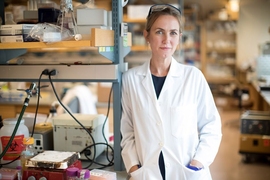Many bacteria that could potentially make us sick normally live in us without doing so, in part because of the protective role that mucus plays in our bodies. This summer, MPC-CMSE Summer Scholar Gaetana Michelet studied how complex materials such as mucus influence bacterial behavior, while working in the Biogel Lab of Katharina Ribbeck, the Eugene Bell Career Development Professor of Tissue Engineering, at MIT.
Michelet, a mechanical engineering student at the University of Puerto Rico, worked with MIT Postdoctoral Associate Gerardo Cárcamo. “We are curious to understand how certain problematic pathogens can live on our body without causing infections. We try to understand the role of mucus in this process,” Cárcamo says. His own research focuses on bacterial interactions such as cell-to-cell communication and bacterial competition in a mucus environment.
During a visit to the lab, Michelet explains that she was working with microbes for her summer internship and learning different techniques used in microbiology, such as growing bacteria in different media, seeing how they interact with materials like mucus, and how they grow in different ways. “For this project, I have integrated my materials science knowledge with the microbiology I've learned here,” she says.
“For me, it has been a real pleasure to work with Gaetana.” Cárcamo adds. “She's a really motivated student willing to learn many new things, and it has been a real good experience.”
Michelet notes that “Although I am a mechanical engineer, I am interested in pursuing a new career in bioengineering, so this summer has been very exciting because I had the opportunity to experience this area, and I think it's a big milestone for my career.”
Michelet’s internship is supported in part by NSF’s Materials Research Science and Engineering Centers program [grant DMR-14-19807]. Participants in the Research Experience for Undergraduates, co-sponsored by the Materials Processing Center and the Center for Materials Science and Engineering, presented their results at a poster session during the last week of the program. The program ran from June 15, 2017, to August 5, 2017, on the MIT campus in Cambridge, Massachusetts.










